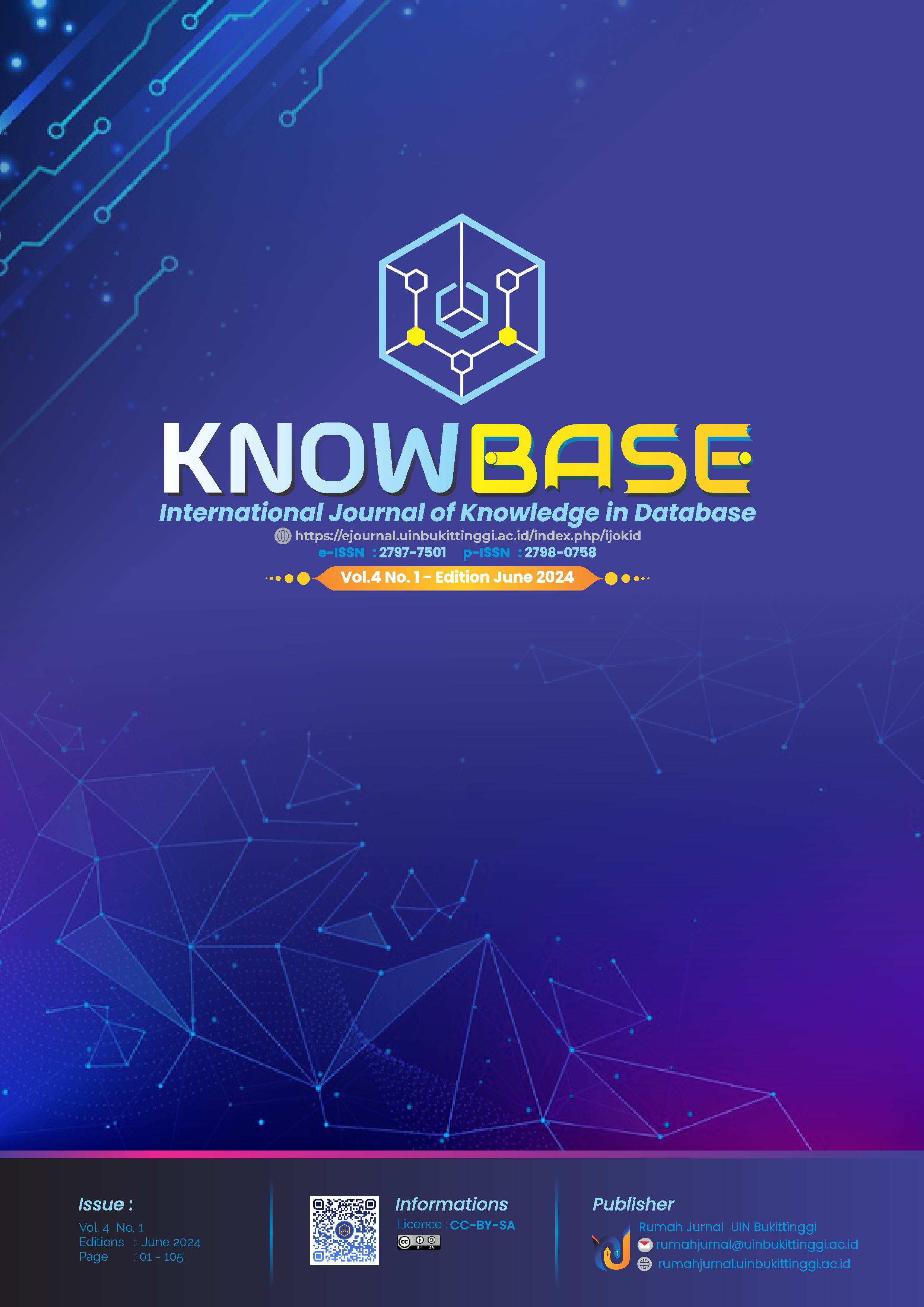Design of a Predictive Model for Prospective New Students Using Monte Carlo Simulation
DOI:
https://doi.org/10.30983/knowbase.v4i1.8144Keywords:
Monte Carlo, Hadith Sciences, Model,, SimulationAbstract
The competition between universities in the admission of new students is becoming increasingly intense, making it more difficult for the public, especially prospective students, to choose a study program. The Department of Hadith Sciences at UIN Syech M. Djamil Djambek Bukittinggi has fewer applicants compared to other departments due to the limited interest of prospective students in enrolling. In response to this issue, the author developed a Monte Carlo simulation predictive model that allows prospective students to estimate the number of applicants to the Department of Hadith Sciences for the upcoming academic year. The research technique employed in this study uses Monte Carlo simulation to apply this research. The number of students in the Department of Hadith Sciences who enrolled from 2019 to 2023 serves as the data used to predict the number of new student registrations. The accuracy of the simulation in estimating the number of new students who will enroll in the Department of Hadith Sciences is 218 students, with an average annual accuracy of 65.1%. By applying the Monte Carlo method, it is possible to predict the number of students who will enroll in the Department of Hadith Sciences with a relatively high level of accuracy in its application
References
A. Al Akbar, H. Alamsyah, and R. Riska, “Simulasi Prediksi Jumlah Mahasiswa Baru Universitas Dehasen Bengkulu Menggunakan Metode Monte Carlo,” Pseudocode, vol. 7, no. 1, pp. 8–16, 2020, doi: 10.33369/pseudocode.7.1.8-16.
T. Nurjanah, “Model-Model Pembelajaran Ilmu Fara’idh,” J. Penelit. Pendidik. Islam, vol. 7, no. 2, p. 225, 2019, doi: 10.36667/jppi.v7i2.365.
M. Galib and M. Hidayat, “FAKTOR-FAKTOR YANG MEMPENGARUHI KEPUTUSAN MAHASISWA DALAM MEMILIH PROGRAM STUDI PADA PERGURUAN TINGGI,” AkMen, vol. 17, no. 2, pp. 173–182, 2020.
A. Nurhuda and N. A. Setyaningtyas, “Implementasi Pembelajaran Ilmu Hadist di MAN 1 Boyolali saat Pandemi,” J. Nusant. Mengabdi, vol. 1, no. 2, pp. 63–76, 2022, doi: 10.35912/jnm.v1i2.663.
S. Chorunnisa, L. Efriyanti, S. Derta, and R. Okra, “Pengaruh Model Pembelajaran Rotation Model Pada Mata Kuliah Model dan Simulasi Terhadap Hasil Belajar Mahasiswa,” Pendidik. dan Konseling, vol. 4, no. 5, pp. 1707–1715, 2022.
K. Alfikrizal, “SIMULASI MONTE CARLO DALAM PREDIKSI JUMLAH PENUMPANG ANGKUTAN MASSAL BUS RAPID TRANSIT,” J. Berk. Epidemiol., vol. 5, no. 1, pp. 90–96, 2020, [Online]. Available: https://core.ac.uk/download/pdf/235085111.pdf%0Awebsite: http://www.kemkes.go.id%0Ahttp://www.yankes.kemkes.go.id/assets/downloads/PMK No. 57 Tahun 2013 tentang PTRM.pdf%0Ahttps://www.kemenpppa.go.id/lib/uploads/list/15242-profil-anak-indonesia_-2019.pdf%0Aht.
E. A. Trianto and A. Yulianeu, “Perancangan Sistem Informasi Pembayaran Abodemen di UPTD Pasar Rajadesa,” Jumantaka, vol. 1, no. 1, pp. 11–20, 2018.
rahmatia wulan Dari, “Simulasi Monte Carlo dalam Prediksi Tingkat Penjualan Produk HPAI,” J. Inform. Ekon. Bisnis, vol. 2, no. 3, pp. 86–91, 2020, doi: 10.37034/infeb.vi0.48.
B. Mulyana Putra, “Jurnal Informatika Ekonomi Bisnis Simulasi Monte Carlo dalam Memprediksi Tingkat Pendapatan Advertising,” J. Inform. Bisnis, vol. 2, no. 3, pp. 80–85, 2020, doi: 10.37034/infeb.v2i3.45.
L. Efriyanti, A. N. Khomarudin, and R. Novita, “Pengembangan multimedia berbasis mobile learning dalam pembelajaran model simulasi pada keilmuan komputer,” J. Inov. Teknol. Pendidik., vol. 8, no. 1, 2021, doi: 10.21831/jitp.v8i1.42635.
anggit teguh Harjanto, “Pengendalian Persediaan pada Perusahaan Retail dengan Adanya Ketidakpastian Permintaan dan Lead Time Menggunakan Metode Simulasi Monte Carlo (Studi Kasus Pada Persediaan Toko Olah Raga Tenqi Sport),” J. Tek. Ind., vol. 1, no. 2, pp. 1–23, 2020.
M. A. Dewi and R. Irham, “Penerapan Agile Scrum Pada Pengembangan Bimbingan Daring Skripsi Mahasiswa,” J. SISKOM-KB (Sistem Komput. dan Kecerdasan Buatan), vol. 4, no. 2, pp. 40–45, 2021, doi: 10.47970/siskom-kb.v4i2.195.
Z. Masrah, “PERSEPSI MAHASISWA TERHADAP JURUSAN DI PERGURUAN TINGGI DAN KONSEP DIRI DENGAN KESESUAIAN MINAT MEMILIH JURUSAN,” Psikolog, vol. 1, no. 2, pp. 1–90, 2018.
Downloads
Published
How to Cite
Issue
Section
Citation Check
License
Copyright (c) 2024 Dela Paramita, Liza Efriyanti, Supratman Zakir, M. Imamuddin

This work is licensed under a Creative Commons Attribution-ShareAlike 4.0 International License.
Authors who publish with this journal agree to the following terms:
- Authors retain copyright and grant the journal right of first publication with the work simultaneously licensed under a Creative Commons Attribution License that allows others to share the work with an acknowledgment of the work's authorship and initial publication in this journal.
- Authors are able to enter into separate, additional contractual arrangements for the non-exclusive distribution of the journal's published version of the work (e.g., post it to an institutional repository or publish it in a book), with an acknowledgment of its initial publication in this journal.
- Authors are permitted and encouraged to post their work online (e.g., in institutional repositories or on their website) prior to and during the submission process, as it can lead to productive exchanges, as well as earlier and greater citation of published work (See The Effect of Open Access).




